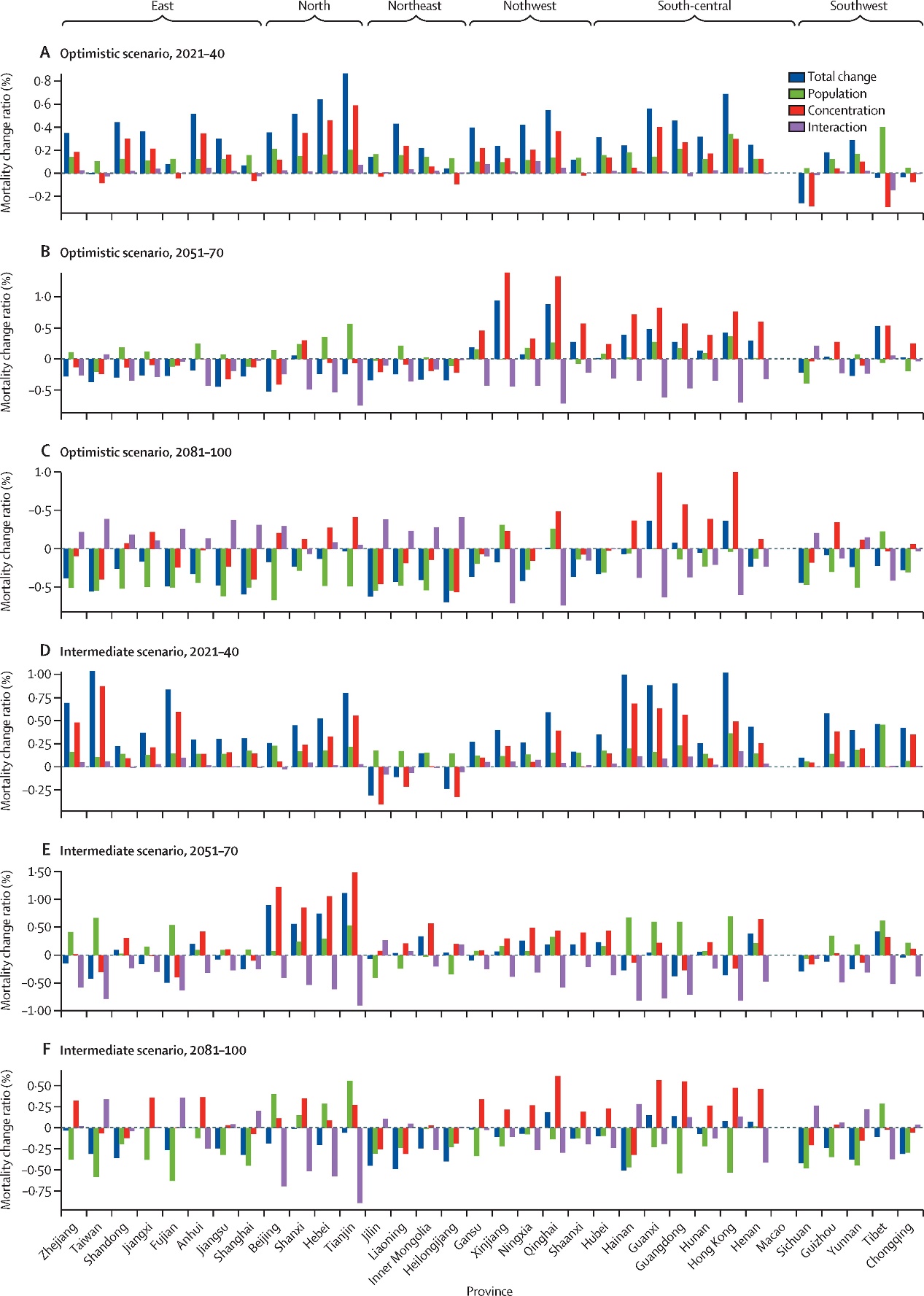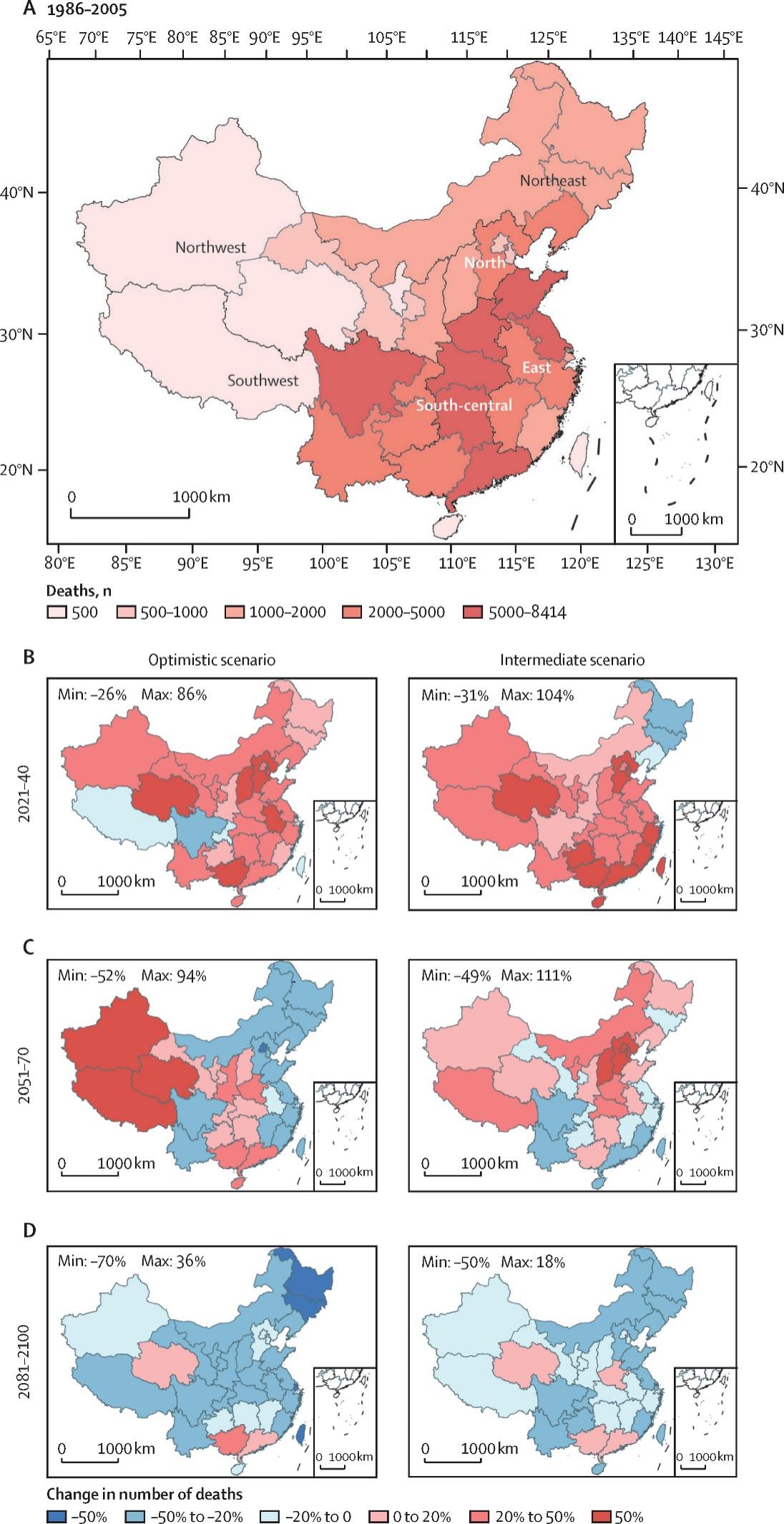Recently, Professor Bai Yuqi’s team of the Department of Earth System Science (DESS), Tsinghua University and Researcher Li Fang’s team from the Institute of Atmospheric Physics (IAP), Chinese Academy of Sciences have jointly completed the research on the regional health effect of landscape fire emissions in China during 2021-2100. Based on the projected future population and landscape fire smoke PM2·5 concentration, the research used the relative risks (RRs) pooled for China, and estimated the number of deaths attributable to landscape fire-related PM2.5 emission among Chinese residents during 2021-2100 under different development pathways and scenarios. Our findings, which disclose the temporal and spatial patterns of the health hazards to Chinese people caused by landscape fires in different periods in the future, could help policy makers formulate and implement effective interventions in advance to reduce the impact of landscape fire smoke on human health in China.
Against the background of climate change, the probability and intensity of landscape fires, including forest fires, grass fires, bush fires, and agricultural-waste burning have drawn extensive attention. The smoke produced by landscape fire emissions, especially PM2.5, has an important health impact on people and therefore calls for very accurate assessment. However, the landscape fires in China are characterized by small scope and short duration. The existing research on the prediction of future fire-related death risk is not detailed to the provincial level, and the adopted parameter settings are not suitable for the health signs of people in China. The prediction method of previous studies only used environmental PM2.5 exposure to estimate the mortality rate, and did not use the epidemiological method developed for fire-related PM2·5 .
In view of the above research gaps, the joint research team estimated the mortality risk attributable to landscape fire emission of PM2.5 under different Shared Socioeconomic Pathways (SSP) scenarios (SSP1-2.6 greenhouse gas emission scenario and SSP2-4.5 greenhouse gas emission scenario) at the provincial level in China. Firstly, the population of China and the landscape fire smoke PM2·5 concentration during the period of 2021-2100 were estimated, and the number of all-cause deaths caused by PM2.5 emitted by landscape fires during this period was predicted by using the epidemiological model for short-term exposure of landscape fires and the relative risk coefficient of China (referring to the total deaths caused by various reasons in a certain period, mainly including deaths caused by the respiratory system and cardiovascular and cerebrovascular problems). The mortality risk of landscape fires was evaluated, and the temporal and spatial distribution pattern of death toll under different climate change scenarios was further analysed.

Figure 1: Projected annual average number of all-cause deaths attributable to changes in the landscape fire-related PM2.5 concentration at the provincial level
The results show that the mortality rate caused by PM2.5 emission from landscape fires in China in the future (2021-2024, 2051-2070 and 2081-2100) will be higher than that in the historical period of 1986-2005, and the average mortality rate will first rise in 2021-2024, and then show a downward trend in 2051-2070 and beyond. In the future, global warming will increase the landscape fire-related PM2.5 concentration, and the average mortality rate related to PM2.5 emitted by landscape fires in the SSP2-4.5 scenario is higher than that in that in the SSP1-2.6 scenario. Compared with the historical period, the number of all-cause deaths caused by PM2.5 emission from landscape fires in China will peak in 2021-2040, and increase by 37.38% under the SSP2-4.5 scenario (95% CI 22.85-62.61%). After the middle of this century, due to the decrease of the total population and the change in population distribution, the number of deaths caused by the emission of PM2.5 from landscape fires in China will decrease slightly (Figure 1). The provinces with the largest number of deaths (Shandong, Henan, Guangdong and Hubei) will be concentrated in the eastern and south-central parts of China (Figure 2), while the provinces with the largest percentage increase in death toll compared with the historical period will be located in the northwest and southwest parts of China.

Figure 2 Spatial and temporal patterns of the projected changes in the annual all-cause deaths attributable to landscape fire-related PM2·5 at the provincial level
The above research results were published online in The Lancet Planetary Health on October 10 in the form of a paper titled “Projections of mortality risk attributable to short-term exposure to landscape fire smoke in China, 2021–2100: a health impact assessment study”.
Lou Shuhan, a doctoral student of the DESS is the first author of the paper, and Professor Bai Yuqi of the DESS and Researcher Li Fang of the Institute of Atmospheric Physics are the co-authors. Other collaborating authors of the paper include Liu Yufu, a doctoral student of the DESS, Researcher Lin Guangxing and Postdoctoral Fellow Xu Lulu of Institute of Atmospheric Physics, lecturer Liu Zhao of Beijing Vocational College of Economics and Management, Assistant Researcher Dong Xiao of the Institute of Atmospheric Physics, postdoctoral fellow Zhao Mengzhen of School of Management and Economics of Beijing Institute of Technology, Wang Lingyu and Jin Meng, doctoral graduates of the DESS, Professor Wang Can and doctoral student Chen Yizhen of Tsinghua University College of Environment, Professor Cai Wenjia of the DESS, and Chair Professor of Global Sustainability and Vice President Gong Peng of the University of Hong Kong. This study has received guidance from the Lancet Countdown Asia Centre and was funded by the National Natural Science Foundation of China (42090015), National Key Research and Development Program of China (2022YFE0106500), the National Natural Science Foundation of China (42275086), and the Wellcome Trust (209734/Z/17/Z). This work was also supported by the National Key Scientific and Technological Infrastructure project Earth System Science Numerical Simulator Facility (EarthLab).